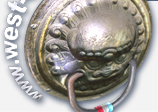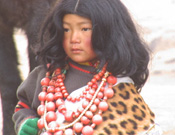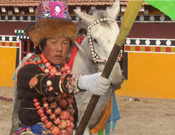| Old Monasteries In Amdo and Kham,
Nyingmapa and Kumbum Festivals
--The best time to view more snow Mountains and Peaks
as well as some traditional Festivals in old monasteries in Amdo
and Kham Eastern Tibet.
Day 1 --In the Flight
Day 2. --Arrive at Beijing
Day 3. --Beijing fly to Xining
Day 4. --Xining/Achung Namdzong
It is an easy drive of 160km to Jentsa Achung Namdzong to visit
an important Nyingmapa (Red sect) monastery, Sangak Tengyeling,
built in 1814 and surrounded by beautiful red mountain peaks, a
very quiet and holy place, including a biggest Nyingmapa nunnery,
Samten Chopeling nearby housing 200 nuns, it is said it was built
in 13th century. During the eighth century, Padmasambhava, a great
Tantric master who first introduced Buddhism to Tibet, blessed his
power to the Local Mountain God to be a local protector and spread
deep knowledge of Buddhism and wisdom to the ground where since
then became a strong magnetic field of Buddhism. Many Lamas and
monks came here to study Buddhism and to meditate in some caves.
Some of them made a great achievement to the Tibetan Buddhism and
become famous masters. Such as Tsang Rabsel, Mar Shakyamuni, Yo-ge
Jung and Lhalung Pelgyi Dorje. They preserved the monastic lineage
and their disciples started the Later Diffusion of Buddhism in central
Tibet after the King Langdarma's severe Movement of Persecution
of Buddhism during the 9th century. Then we drive 40km to Lijiaxia
Hydro Power Station Hotel** for overnight.
Day 5. --Jentsa/Shyachung/Kumbum
Monastery
The monastery Namdzong Sangak Tengyeling has another two branch
monasteries separated in different cultivated mountain valleys nearby.
They are Dorjia and Geiwa Erkhang monastery. Every year, monks of
three monasteries work together to hold a big Nyingmapa festival
in each monastery by turns. The festival is an impressive Masks
Dance by Nyingmapa masters with their very old and unique traditional
way, which is quite different performance from Gelukpa monasteries.
It is one of the biggest local religion festivals during a year,
so it attracts hundreds of local people for pilgrimage, but almost
no any tourists to visit. In 2006, the festival will be rotated
in Dorjia monastery located 45km away from the hotel. After festival,
we drive for 70km to visit Shachong monastery (Jakhyung Shedrubling).
This is one of the most historic and renowned Gelukpa monasteries
of Amdo, founded in 1349 by Lama Dondrub Rinchen (1309-1385), the
teacher of Tsongkhapa. Prior to the Gelukpa foundation, Karmapa
2, Karmapakshi in the 12th century, had built an earlier monastery
on the same site. Later, following the Gelukpa foundation in 1409,
the monastery was listed, along with Serkhok, Chubzang and Gonlung,
as one of the four great monasteries of the north, a phrase used
in Amdo to signify the oldest and most significant Gelukpa institutions
of the region. It was here that Tsongkhapa became a monk to study
Buddhism when he was seven years old, and studied until leaving
Amdo for Lhasa at the age of 16 in 1372. Historically, several scholars
had studied here and later became the teachers of Dalai Lama 7,
8, 9 and 10. The monastery once housed more than 3000 monks and
now has 400 monks to study here. After visiting, we drive 97km to
Kumbum monastery. Overnight Kumbum Tsongkha Hotel ***
Day 6. --Kumbum
Visit Monastery-Festival. We see the masks dance by lama artists,
which happens only twice a year in Summer time. The performance
starts at 1:00 PM and finishes at 4:00 PM. The Gelukpa (Yellow sect)
founder Tsongkhapa was born here in 1357 and the third Dalai Lama
built this monastery in 1560 in memory of this great master. It
is one of the six important and famous Gelukpa high institute monasteries
in whole Tibet. Two of Tsongkhapa important disciples became the
Gelukpa ancestors of Living Buddha system, Dalai and Panchen Lama.
The high level art works of its old frescos, appliqués and
butter sculptures are known as three wonders of the monastery and
now it has 500 monks.
Day 7. -- Kumbum/Xining
To see whole procession of Sunning the Buddha, a big Tangkha 40m
long 20m wide carried by monks to display on a mount slope for the
Commemoration Day of Enlightenment of Buddha Shakyamuni. Meanwhile
in front of the big Buddha monks and believers pray for good rain
for crops and grassland in order to have a good harvester of the
year. In the afternoon to see Masked Dance of Hayagriva (Horse Headed
Protector King), then drive 35km to Xining. Overnight in Qinghai
hotel****
Day 8. --Xining
Drive for about 108km via Taktser (Hongyacun) of Tsongkha Khar (Pingan)
County to pay a visit of Shadzong monastery in Sanhe Township. Shadzong
means a place where deer live in quite. In old days, it was a quite
place hidden in a forest where attracted many Buddhists to be here
for meditations. One of them was Tsongkhapa’s teach Robe Dorje
(1340-1383) and he held a ceremony for Tsongkhapa to be initiated
into monk hood and became ordained as renunciation in this monastery
when Tsongkhapa was only three years old in 1360. Overnight Qinghai
Hotel ****
Day 9. --Xining/Machen
Drive 360km (8hours) to Machen County (Alt: 3800m). Another wonderful
day for picturesque landscape while we drive: grassland with yaks
and sheep, nomadic black and white tents. Along the Yellow River
valley we will experience the red and Blue Mountains with colorful
flowers and some barley land and forestry. This part of driving
concentrates many futures of Amdo, the scenery is fantastic changeable
geographically at every short distance. Machen in Tibetan means:
The highest mountain of the Yellow River. The county is the homeland
of the Tibetan Golok people, another strong tribe of Tibetan. The
Golok means: Marching strait ahead and never turn back your head.
Overnight Snow Mountain Hotel or other better Hotel, sometime no
hot water for shower.
Day 10. -- Machen/Padma (Banma)
If you want to have an experience of a real wild area, today’s
320km driving will make you satisfactory, we will pass over at least
three big mountain passes with altitude over 4200 meters, decorated
with different coloured pray flags. You will meet many typical Golok
nomadic people on the way, they are strong and nice, every aged
people’s charming face just like a world classics, it is whom,
the nomadic people live nearest to the nature for thousands of years
and accumulated rich knowledge about life which also full of various
romantic stories. We believe that because of their clean minds with
kind hearts, most of their bodies remain much more instinct feelings
to receive the positive energy from the nature and helpful waves
from the monasteries. We will also visit one or two old monasteries
on the way. Overnight Banma Government Guest House**
Day 11. -- Padma (Banma)
We should stay at Baima for another day, as we want to rest a little
and have more time to absorb the atmosphere, which is still not
open officially for foreign visitors so far. We at least will visit
three old monasteries with distinctive feature that will deeply
impress you for a long time. Today we travel about 10km down the
road along one of the tributaries of the Yangtze to visit a monastery
belonging to the almost extinct Jonang Sect Yartangjia (Akyong gya)
Gompa, which was founded in the Western Tibet during the 13th century,
characteristically with three beautiful high Jonangpa Chortans,
tower-like temples with big eyes on them that are worth the trip.
The main monastery suffered damage in the Cultural Revolution and
has not been rebuilt, but a group of monks still live and pray here.
Nearby is a most unusual stone complex called Jaree, belonging to
yet another sect. Another monastery nearby is Nyingmapa Jangritang
Gompa, in the middle of the site, a beautiful crafted brown wooden
tower, a really artistic construction, which is surrounded with
about a hundred chortens of all different sizes. The valley is beautiful
and there will be visit the sky burial site if no burials are taking
place. It is marked by thousands of ochre colored prayer flags a
last and dignified memorial to the dead.
Overnight Lianhua Hotel **
Day 12. -- Padma/Ngawa(Aba)
Drive 276km via Jiuzhi (Jiddril) to Ngawa (Chi: Aba Alt: 3200m).
We will stop to visit a small Nyingmapa monastery Taklung Gonpa,
built in 200 year ago. At background of the compa, a great tract
of bright red pray flags covered almost all mountain hillsides making
a great view. Another attraction on the way is Tibetan farmer’s
houses that are so different from what we have seen and we are going
to see after Ngawa. In Tibetan Ngawa means: Men who beat drums.
The old people explain Ngawa is the first place where the King Songtsen
Gampo conferred and awarded the title to warriors during the 7th
century. For centuries, Ngawa is one of the largest nomadic areas
in Eastern Tibet and one of the important Tibetan cities in Amdo
as well as the central of Tibetan culture, religion, trade and communication.
Overnight Jingu Hotel.**
Day 13. -- Ngawa(Aba)
Ngawa was officially open for foreign tourists since last year when
the city looks more modern somehow. But those old different sect
monasteries are still worth seeing, as they are rear to see in Central-Tibet
nowadays from which we will learn more about Tibetan culture and
history. Nangshuk (Narshi) Monastery, the largest Bon monastery
in Tibet has 800 monks now. The monks from Benpo always say, they
are real Tibetan indigenous religion, because it is the Ben religion
started from Tibet since at least 6,000 years ago and history is
much longer than any other sects in Tibet. We will visit one of
the oldest and few sects Jonangpa Ser (Setenling) Gonpa housing
about 1000 monks. Jonangpa or Jonang Sect was first founded in the
middle of 13th century, till 14th century, this sect became one
of the strangest religions in Tibet and spread to Amdo during that
time. During 17th century, the fifth Dalai Lama changed most Jonangpa
monasteries to Gelukpa, and only few were left in remote areas,
such as in Zamtang, Padma and Ngawa. Then we visit Gelukpa Kirti
Gompa, this monastery acts as the center of the town and is one
of the largest scale monasteries in Aba (Ngawa) county, was built
in 15th century and housing more than 1000 monks. Overnight Jingu
Hotel.** or a new Hotel.
Day 14. --Ngawa / (Barkham)Markang
Geographically, during our today’s 260km driving, after passing
through several high mountain passes covering with snow and forestry,
we leave the wild area of the upper reaches of the Yellow River
and drive into the upper reaches of the Yangtze River’s high
mountainous area. Because of different living environment, we will
see different tribes of peoples, the Qiang people, Tibetan Gyarong
and Tibetan Khampa peoples with distinctive habit, costume and dialects,
who live not only on the grassland but also forestry and agriculture
farmland along countless tributaries of the Yangtze River. Overnight
Markang Hotel **
Day 15. -- Barkham(Markang)/Ganzi
Driving 350 km to Ganzi, like always we say that the grassland in
Amdo is paradise, while enjoying the landscape in Kham area is just
like enjoying your favorite masterpiece of music. The melody comes
to your eyes and ears from the high mountain ranges covering with
snow and forestry, the deep rivers following up and down steep gorges,
the highland crops and plants, especially the different style of
Tibetan houses on the way, all make you exciting. Ganzi was once
the largest and most important town in Kham built by the Mongols
in the 17th century. Ganzi Gompa is in the town and we will also
visit very old Den Gonpa, a very important protector monastery.
Overnight Khampa Hotel**, with facilities in the rooms.
Day 16. -- Ganzi / Derge
About 84km we pass a small town Manigango at the T-intersection,
one road to Derge and another to Jyekundo. Most of the houses in
Manigango are made of timber and a small place where for truck drivers
and nomads’ shopping, lunch and overnight. The famous holly
and one of the most beautiful Lakes Yilhun Lhatso is 15km from here
on the way to Derge. Starting from here we drive up to Tro La pass
at 5080m and all the way down to Derge is 90km. Derge Guest House
**
Day 17. -- Derge
Derge, in Tibetan means: A village of doing good things. A charming
place which has been giving people wishful thinking to go at home
and broad, now still preserve its old traditional way of life in
many aspects. The town is located in a nice valley and the Zi-chu,
one of the tributaries of the Yangtze River flows across the small
town, adding more beauty. We will visit the famous Parkhang Printing
House, Gonchen Monastery and a very old Temple of Tangtong Gyelpo
was built in memory of Tibet’s first multi-talented bridge-builder,
dramatist, engineer and treasure-finder during 11th century. Besides
beautiful surroundings, you will be touched by all old monasteries
in Derge, arousing your deep imagination of her past. Overnight
Derge Guesthouse
Day 18. -- Derge / Pelyul (Baiyu)
Driving along the Zhi-chu valley for about half an hour, we will
move into grand up reaches of the Yangtze River Gorges. Tibetan
houses and villages standing at the foot of different shapes of
high gorges by the Yangtze, under the bright sun shine, the fantastic
view with fresh air, the quiet place with only sound from the river
will make you hate to leave here. We will drive about for 5 hours
to arrive in our today’s destination and shining golden roofed
Pelyul Monastery comes first into your view. Pelyul is also a small
town with another tributary of the Yangtze, Ngu-chu separating the
town into two parts. Like Gelukpa six major high teaching monasteries,
the Samye(built in 775 AD), Katok(1159), Pelyul(1665), Mindroling(1670)
and Dzogchen(1684) monasteries are 5 important Nyingmapa schools
and Nyingmapa means the oldest sect. Upon arrival after checking
in our hotel, we will visit Pelyul monastery, but most part of it
is newly reconstructed after 1980s and some are still under constructions.
Overnight Pelyul Guesthouse House with facilities in the room.
Day 19. -- Pelyul (Baiyu)
If the weather is fine, we will drive for about 60km to visit Katok
monastery built in 1159, one of the important and famous monasteries
at home and abroad for Nyingmapa believers as many famous scholars
and masters graduated from here for centuries. This old and isolated
monastery is a really good place for training high-level monks as
well as an ideal ground for meditation. Most Nyingmapa monks, usually
study at home or in mountain caves, during the religious activities
and festival time, they gather in the monastery. After visit, we
drive back to our hotel.
Day 20. -- Pelyul/Ganzi
We take another road driving back 245km to Ganzi, some parts of
road are not so good but landscape is fabulous, high snow mountains,
clean rivers, forestry and the best grassland view, different designed
prey flag’s sites and a very old small monastery is just by
the road, rounded with many sheep skin wrapped prey wheels which
magically make you have a feeling of going back several hundred
years ago and that seems you have experienced different lives in
the past few centuries when you walk around them. Nearby there is
Mani stones piled up with many died animal’s bones, it is
true those animals need to be preyed for ever as they always help
people for surviving since human being started. Between 6 to 7 pm,
we will arrive Ganzi, overnight Golden Yak Hotel**.
Day 21. -- Ganzi/Kangding (Dartsodo)
Driving 290km to Dartsodo (Kangding) once was the main center for
the tea-trade between Tibet and China as well as one the five independent
kingdoms of Kham. Today Dartsodo is a quite modern city and we come
here is just for overnight. But highlight to see is on the way different
Tibetan farmers’ houses. Overnight Kangding Hotel.
Day 22. -- Chengdu
Driving for 400km to Chengdu. Overnight 4 stars Hotel in Chengdu.
Day 23. -- Chengdu/Beijing
Fly to Beijing, all day is free for leisure. Overnight Beijing Jianguo
Hotel.
Day 24. -- Beijing/Back Home
Transferring from your hotel to Beijing International Air Port to
take your flight back home.
Tour Includes:
• All transportation (land & air) within the tour inside
China and Tibet
• Accommodations at four star international standard deluxe
hotels in Beijing, Xining, and Chengdu, the best local hotels with
standard rooms in Amdo and Kham area
• All meals during the tour
• Good Japanese Landcruiser and tree person sharing one car
• Native Tibetan/English speaking guide
• All entrance fee
• Comprehensive sightseeing
|





